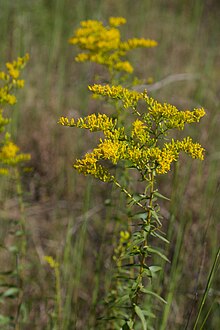Solidago odora
Appearance
| Solidago odora | |
|---|---|

| |
| Scientific classification | |
| Kingdom: | Plantae |
| Clade: | Tracheophytes |
| Clade: | Angiosperms |
| Clade: | Eudicots |
| Clade: | Asterids |
| Order: | Asterales |
| Family: | Asteraceae |
| Genus: | Solidago |
| Species: | S. odora
|
| Binomial name | |
| Solidago odora | |
| Synonyms[1] | |
|
Synonymy
| |
Solidago odora, the sweet goldenrod, anisescented goldenrod or fragrant goldenrod, is a North American species of goldenrod within the family Asteraceae.[2] The plant is native to the United States and Mexico, found in every coastal state from Veracruz to New Hampshire and as far inland as Ohio, Missouri, and Oklahoma.[3] It flowers from July through October.
- Solidago odora subsp. odora - most of species range
- Solidago odora subsp. chapmanii (Gray) Semple - Florida and Southern Georgia only
As a traditional medicine, Solidago odora has a variety of ethnobotanical uses, especially by the Cherokee.[7]
The leaves, which smell of licorice when crushed, can be made into a tea.[8]
Galls
[edit]This species is host to the following insect induced galls:
- Eurosta lateralis (Wiedemann, 1830)
- Procecidochares atra (Loew, 1862) (summer and autumn generations)
- Calycomyza solidaginis Kaltenbach, 1869[9]
References
[edit]- ^ The Plant List, Solidago odora Aiton
- ^ USDA, NRCS (n.d.). "Solidago odora". The PLANTS Database (plants.usda.gov). Greensboro, North Carolina: National Plant Data Team. Retrieved 19 November 2015.
- ^ Biota of North America Program 2014 county distribution map
- ^ Flora of North America, Solidago odora Aiton, 1789. Anise-scented or fragrant or sweet goldenrod
- ^ Integrated Taxonomy Information System ITIS Accessed Sept 28, 2014.
- ^ "Solidago odora". Germplasm Resources Information Network. Agricultural Research Service, United States Department of Agriculture. Retrieved September 28, 2014.
- ^ Hamel, Paul B. and Mary U. Chiltoske (1975). Cherokee Plants and Their Uses —A 400 Year History. Sylva, NC: Herald Publishing Co. p. 36.
- ^ Niering, William A.; Olmstead, Nancy C. (1985) [1979]. The Audubon Society Field Guide to North American Wildflowers, Eastern Region. Knopf. p. 404. ISBN 0-394-50432-1.
- ^ Kaltenbach, J.H. (1869). "Die deutschen Phytophagen aus der Klasse der Insekten [concl.]". Verh. Naturh. Ver. Preuss. Rheinl. 26 (3, 6): 106–224.
